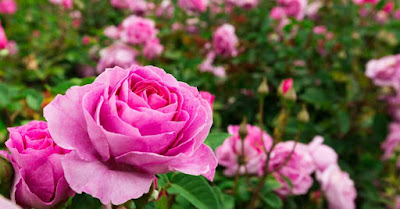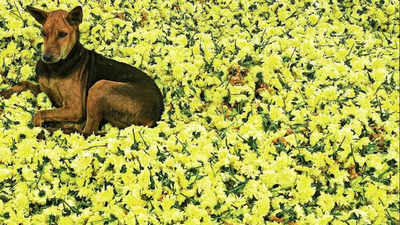Start with S - 16 Flowers Names and Types with Pictures
Start with S - 16 Flowers Names and Types with Pictures
Sage
Sage is both an herb and a perennial plant. It is commonly used in culinary pursuits, where it may be used as a seasoning. The plant can also be used ornamentally, with blue blooms in June.
From the Mediterranean region, the leaves are gray green and fragrant, and they are the part typically used in cooking.
Saint John’s Wort
Saint John’s Wort is a perennial flowering herb, native to Europe and Asia. It grows into a deciduous shrub between 3 and 4 feet tall.
The herb has yellow flowers and grows wild. Saint John’s Wort goes by a variety of names including Goatweed, Hypericum, and God’s Wonder Plant. It attracts bees, birds, and butterflies.
Saint John’s Wort has been used for treating mental health issues such as depression, insomnia, and anxiety issues.
Scaevola
Scaevola also goes by the name of Fairy Fan Flower. The Fairy Fan Flower sports dainty blossoms in shades of pink, white, blue, and purple with foliage ranging from blue to green.
It is a popular flower bed and hanging plant due to vine-like growth. Scaevola is a native plant of Australia and is resistant to droughts and heat. The Fairy Fan Flower is also helpful in butterfly gardens.
Scented Geranium
Scented Geraniums are members of a group called Pelargonium that are known for accented or aromatic leaves.
Besides being ornamental in nature, the sweet-smelling foliage is evergreen and can be dried and used in sachets and potpourris. The plant flowers throughout summer with pleasing light pink 5-petaled blossoms.
Scilla
Scilla is a member of the Asparagaceae family originating in Eurasia, Africa, and the Middle-East. It is a perennial bulb plant, also called Siberian Squill.
In nature, Scilla is found from seashores to fields and forests. Blooming in the early days of April, on a 3 to 6 inch stem, appear green leaves and vivid blue bell flowers with matching anthers.
Sedum
Sedum, also known as stone crop or gold moss stonecrop, is a succulent perennial that thrives in full sun and requires little water.
It is a spreading evergreen ground cover with fleshy stems and thick leaves that overlap like roof tiles. Small star-looking 5 petal flowers bloom in clusters throughout the summer months.
Shasta Daisy
Species of Leucanthemum are commonly referred to as Shasta Daisies. These flowers can grow to heights as tall as 4 feet, and they bloom between July and September.
The blooms feature rays of white petals around a central yellow disc. They need full sun and make excellent cut flowers.
Silene
Silene is a perennial member of the Caryophyllaceae family, nicknamed campion or catchfly. It has sticky stems that explain the catchfly label.
Originating in Europe, it grows 12 to 16 inches with leaves ranging from gray to green. The flowers appear in late summer and range in shades of pink to purplish red-pink.
Snapdragon
The Snapdragon is also known as antirrhinum, a plant that comes in three different groups depending on its size, and they need full sunlight.
There is a wide selection of colors, from solid colors to bicolor to doubles. The name comes from plants of older varieties opening when they were squeezed at the sides.
Snowdrop
The Snapdragon is also known as antirrhinum, a plant that comes in three different groups depending on its size, and they need full sunlight.
There is a wide selection of colors, from solid colors to bicolor to doubles. The name comes from plants of older varieties opening when they were squeezed at the sides.
Snowflake
Snowflakes are bulbous perennials and part of the Leucojun family. These plants are native to Europe. Blooms appear in mid-spring and droop from tall stems.
The snow-colored flowers from a delicate bell-shape in clusters of 4 to 8. These are hardy plants and have been favored as “pass-alongs” for generations.
Soapwort
Soapwort is a perennial member of the carnation family and is also called Wild Sweet William, soap weed, bouncing-bet, and crow soap.
Native to Europe, soapwort can be seen in summer growing along roadsides. As a cultivated plant, soapwort grows approximately 1 to 2 inches tall with blooms ranging in shades from white to rose pink.
Speedwell
Speedwell, also called bird’s eye or gypsy weed, is a hardy perennial native to Europe. Speedwell grows in a variety of heights ranging from 4 to 18 inches. The plant has is slightly scented and spreads quickly.
Speedwell flowers are found in shades of pink, purple, blue, and white. The plant is known for “Old World” charm.
Starflower
Starflowers (also known as Trientalis borealis or Lysimachia borealis) are perennials that grow from skinny rhizomes and are a part of the Primrose flower family. Starflowers are low-growing wildflowers native to North America. They are one of the most frequently found spring wildflowers.
They grow in wooden areas and fields, blooming in the cool temperatures of spring and early summer. Flowers are pure white stars made up of 7 tiny petals growing on short to no stems with a circular grouping of 5 to 9 leaves.
Statice
Statice is a member of the Limonium which contains at least 120 flowering species. The plant is also known as sea lavender, march-rosemary and caspia.
It is resistant to deer and grows best in sandy soil and full sun. Flowers are also lacy and come in light shades of purple, white and pink. Some Statice varieties have a foul odor.
Sunflower
Sunflowers are native to North and Central America and are part of the 70 species Aster family. They are grown as attractive cut flowers, with edible components for human and animals, and it is used to make yellow dye, lubricants, paints and oils. The fruit of the sunflower is an edible seed called achene.
Flowers grow resembling huge disc shapes on rough furry stems with layers spirals of course leaves. Blooms typically come in shades of yellow and brown. Smaller varieties form petal flowers and are mostly yellow in color.
Sweet Pea
The Sweet Pea plant is also known as Lathyrus. There are two major classes of this plant, there are dwarf varieties and tall climbing varieties.
The flowers come in a range of colors, such as pink, white, and blue. These annuals tend to be hardy and easy to grow, making them popular plants.
1) Start with A - 16 Flowers Names and Types with Pictures
2) Start with B - 28 Flowers Names and Types with Pictures
3) Start with C - 33 Flowers Names and Types with Pictures
4) Start with D - 16 Flowers Names and Types with Pictures
5) Start with E - 9 Flowers Names and Types with Pictures
6) Start with F - 14 Flowers Names and Types with Pictures
7) Start with G - 8 Flowers Names and Types with Pictures
8) Start with H - 15 Flowers Names and Types with Pictures
9) Start with I - 15 Flowers Names and Types with Pictures
10) Start with J - 3 Flowers Names and Types with Pictures
11) Start with K - 5 Flowers Names and Types with Pictures
12) Start with L - 16 Flowers Names and Types with Pictures
13) Start with M - 12 Flowers Names and Types with Pictures
14) Start with N - 7 Flowers Names and Types with Pictures
15) Start with O - 9 Flowers Names and Types with Pictures
16) Start with P - 21 Flowers Names and Types with Pictures
17) Start with Q - 5 Flowers Names and Types with Pictures
18) Start with R - 5 Flowers Names and Types with Pictures
19) Start with S - 16 Flowers Names and Types with Pictures
Powered by:
@AnandDewangan


























Comments
Post a Comment
If you have any doubts, Please let me know